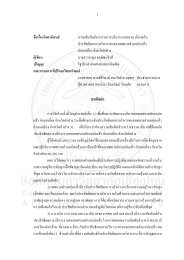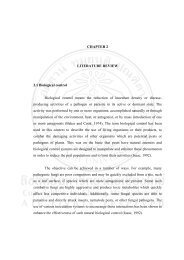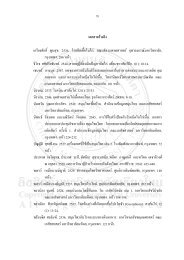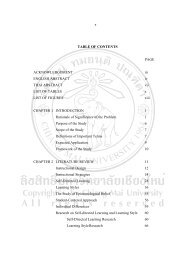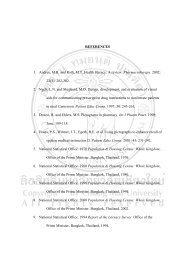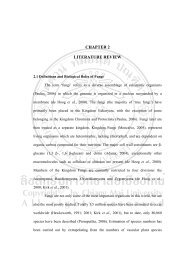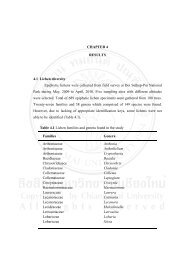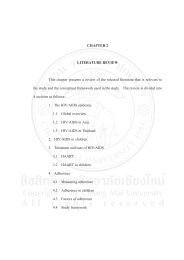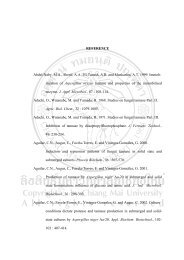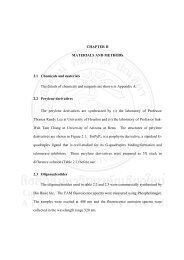chapter 3 a study about inoculation levels of probiotic bacteria in ...
chapter 3 a study about inoculation levels of probiotic bacteria in ...
chapter 3 a study about inoculation levels of probiotic bacteria in ...
You also want an ePaper? Increase the reach of your titles
YUMPU automatically turns print PDFs into web optimized ePapers that Google loves.
CHAPTER 3<br />
A STUDY ABOUT INOCULATION LEVELS OF PROBIOTIC<br />
BACTERIA IN GOAT AND COW MILK YOGHURT<br />
AND THE PRODUCTION AND SHELF LIFE OF<br />
THE YOGHURT POWDER<br />
INTRODUCTION<br />
There are some differences <strong>in</strong> the growth <strong>of</strong> yoghurt starter culture and<br />
<strong>probiotic</strong> <strong>bacteria</strong> between addition <strong>in</strong> yoghurt before and after fermentation.<br />
Ishibashi and Shimamura (1993) recommended <strong><strong>in</strong>oculation</strong> <strong>of</strong> S. thermophilus and<br />
bifido<strong>bacteria</strong> simultaneously dur<strong>in</strong>g fermentation s<strong>in</strong>ce bifido<strong>bacteria</strong> are anaerobic<br />
and S. thermophilus has a high oxygen utilization ability, which results <strong>in</strong> removal <strong>of</strong><br />
dissolved oxygen <strong>in</strong> the product and enhances the viability <strong>of</strong> bifido<strong>bacteria</strong>. On the<br />
other hand, Modler and Villa-Garcia (1993) suggested that the cells <strong>of</strong><br />
Bifidobacterium spp. should be added <strong>in</strong>to the yoghurt after fermentation.<br />
Several factors have been claimed to affect the viability <strong>of</strong> <strong>probiotic</strong> culture<br />
<strong>in</strong> fermented milk products. Acidity and pH have been identified to have an effect<br />
dur<strong>in</strong>g manufacture. Other factors, such as temperature <strong>of</strong> storage, oxygen content,<br />
concentration <strong>of</strong> lactic acid, etc., have been presumed to affect the viability <strong>of</strong><br />
<strong>probiotic</strong> organism <strong>in</strong> yoghurt (Prajapati and Dave, 1994; Samona and Rob<strong>in</strong>son,<br />
1994; Rybka and Kailasapathy, 1995). Improvement <strong>of</strong> the shelf life <strong>of</strong> yoghurt can<br />
be obta<strong>in</strong>ed by lower<strong>in</strong>g its water content or by dra<strong>in</strong><strong>in</strong>g <strong>of</strong> whey. Another method is<br />
dry<strong>in</strong>g, e.g. freeze-, spray or microwave-dry<strong>in</strong>g, the primary objective <strong>of</strong> which is to<br />
preserve the product <strong>in</strong> a shelf-stable powder form <strong>of</strong> high quality without the need<br />
for refrigeration. Dried yoghurt requires less packag<strong>in</strong>g and storage costs because <strong>of</strong><br />
the reduction <strong>of</strong> bulk, and no refrigeration is required. Freeze dry<strong>in</strong>g generally results<br />
<strong>in</strong> better survival <strong>of</strong> starter culture when compared with other commonly used<br />
methods, e.g. spray dry<strong>in</strong>g (Rybka and Kailasapathy, 1995). Spray dry<strong>in</strong>g is reported<br />
to have marked detrimental effects on the physico-chemical, microbiological<br />
characteristics and the flavour <strong>of</strong> the yoghurt powder (Groux, 1973).
47<br />
The packag<strong>in</strong>g plays a fundamental role <strong>in</strong> ma<strong>in</strong>ta<strong>in</strong><strong>in</strong>g the quality and shelflife<br />
<strong>of</strong> foods. The package is an <strong>in</strong>tegrated part <strong>of</strong> the preservation system and<br />
functions as a barrier between the food and the external atmosphere. The package<br />
should be designed and developed not only to hold the food product, but also to<br />
protect it and add value to it, s<strong>in</strong>ce its design may directly affect the purchase decision<br />
<strong>of</strong> the consumer (Roberston, 1993). The <strong>in</strong>corporation and viability <strong>of</strong> <strong>probiotic</strong><br />
<strong>bacteria</strong> <strong>in</strong> foods throughout storage which result <strong>in</strong> health benefits for the host is a<br />
constant challenge for the food <strong>in</strong>dustry and requires the understand<strong>in</strong>g <strong>of</strong> all <strong>in</strong>tr<strong>in</strong>sic<br />
and extr<strong>in</strong>sic factors associated with process<strong>in</strong>g, <strong>in</strong>clud<strong>in</strong>g the selection <strong>of</strong> type <strong>of</strong><br />
packag<strong>in</strong>g material. Mattila-Sandholm et al. (2002) reported that the packag<strong>in</strong>g<br />
materials and the storage conditions are important factors for the quality <strong>of</strong> products<br />
conta<strong>in</strong><strong>in</strong>g <strong>probiotic</strong> microorganisms. In view <strong>of</strong> the ecology <strong>of</strong> the stra<strong>in</strong>s normally<br />
used <strong>in</strong> <strong>probiotic</strong> products – anaerobic and microaerophilic ones – the level <strong>of</strong> oxygen<br />
with<strong>in</strong> the package dur<strong>in</strong>g storage <strong>of</strong> the product should be as low as possible <strong>in</strong> order<br />
to avoid toxicity and death <strong>of</strong> the microorganism and the consequent loss <strong>of</strong><br />
functionality <strong>of</strong> the product. Exposure to dissolved oxygen dur<strong>in</strong>g process<strong>in</strong>g and<br />
storage is highly detrimental to B. bifidum and L. acidophilus. Contrary to aerobic<br />
microorganisms, which completely reduce oxygen to water, the absorption system <strong>of</strong><br />
this substance is m<strong>in</strong>imal or even completely non-exist<strong>in</strong>g. The absence <strong>of</strong> an electron<br />
transport cha<strong>in</strong> results <strong>in</strong> the <strong>in</strong>complete reduction <strong>of</strong> oxygen to hydrogen peroxide. In<br />
addition, these <strong>probiotic</strong> <strong>bacteria</strong> do not produce catalase, an enzyme essential to the<br />
breakdown <strong>of</strong> hydrogen peroxide, a characteristic that consequently leads to the<br />
accumulation <strong>of</strong> derived toxic metabolites, such as superoxide anion (O2 - ), the<br />
hydroxide radical (OH - ), hydrogen peroxide (H2O2) <strong>in</strong> the cell, caus<strong>in</strong>g its death. This<br />
suggests that <strong>probiotic</strong> stra<strong>in</strong>s may be affected by H2O2 produced by other cultures<br />
present <strong>in</strong> the reaction medium. This has motivated several studies aimed at<br />
develop<strong>in</strong>g alternatives that m<strong>in</strong>imize these negative effects, among which the most<br />
promis<strong>in</strong>g are those evaluat<strong>in</strong>g the addition <strong>of</strong> antioxidants, such as ascorbic acid and<br />
the elim<strong>in</strong>ation <strong>of</strong> peroxide produc<strong>in</strong>g stra<strong>in</strong>s (Adriano et al., 2007).<br />
In this <strong>study</strong> section, the viability <strong>of</strong> yoghurt starter culture and <strong>probiotic</strong> <strong>in</strong><br />
goat and cow milk yoghurt was assessed. Differences between addition <strong>of</strong><br />
microencapsulated <strong>probiotic</strong> <strong>in</strong> yoghurt before and after fermentation were
48<br />
monitor<strong>in</strong>g. The effect <strong>of</strong> dehydration methods (spray dry<strong>in</strong>g and freeze dry<strong>in</strong>g) and<br />
different packag<strong>in</strong>g materials on the survival <strong>of</strong> studied microorganisms were also<br />
<strong>in</strong>vestigated.<br />
3.1 LITERATURE REVIEW<br />
3.1.1 Probiotic Bacteria<br />
Cultured dairy products, along with other lactic acid-fermented foods,<br />
have been part <strong>of</strong> the human diet for thousands <strong>of</strong> years and are still considered<br />
therapeutic food dur<strong>in</strong>g sickness <strong>in</strong> many cultures. The Nobel laureate and director <strong>of</strong><br />
the Pasteur Institute <strong>in</strong> Paris, Elie Metchnik<strong>of</strong>f, is generally credited with hav<strong>in</strong>g<br />
formulated a hypothesis expla<strong>in</strong><strong>in</strong>g the health benefits <strong>of</strong> yoghurt <strong>bacteria</strong> <strong>in</strong> the early<br />
part <strong>of</strong> the 20 th century. Studies on yoghurt starter culture and other lactic acid<br />
<strong>bacteria</strong> were conducted throughout the last century. It was only <strong>in</strong> recent decades,<br />
however, that reproducible data began to accumulate which <strong>in</strong>dicated that some<br />
microbial preparations could beneficially affect human health. The term “<strong>probiotic</strong>”,<br />
def<strong>in</strong>ed as live microbial feed supplement which beneficially affects the host animal<br />
by improv<strong>in</strong>g its <strong>in</strong>test<strong>in</strong>al microbial balance, has become widely established. The<br />
def<strong>in</strong>ition has been broadened s<strong>in</strong>ce then to <strong>in</strong>clude human use for organs and tissues<br />
other than the gastro<strong>in</strong>test<strong>in</strong>al (GI) tract and to encompass effects not directly<br />
mediated by the micr<strong>of</strong>lora. In view <strong>of</strong> evidence that nonviable microbes can also<br />
exert health benefits, several def<strong>in</strong>itions no longer require that microbes have to be<br />
alive <strong>in</strong> order to qualify as <strong>probiotic</strong>s (Caglar, 2005).<br />
3.1.2 Probiotic Genera and Stra<strong>in</strong>s<br />
The two most commonly-used <strong>probiotic</strong> <strong>bacteria</strong> are bifido<strong>bacteria</strong> and<br />
lactobacilli, but other lactic acid <strong>bacteria</strong> and even yeast stra<strong>in</strong>s also qualify (Table<br />
17). It has only been after the development <strong>of</strong> molecular biology methods that many<br />
<strong>of</strong> the <strong>in</strong>dividual <strong>bacteria</strong>l stra<strong>in</strong>s were identified unambiguously (Kle<strong>in</strong> et al., 1998).<br />
Lactobacilli are Gram positive, non-form<strong>in</strong>g, microaerophilic rods that<br />
produce abundant lactate as an end product and can be H2O2-produc<strong>in</strong>g or not.<br />
Several recent studies us<strong>in</strong>g molecular biology techniques on fecal samples <strong>in</strong>dicate<br />
that the <strong>in</strong>test<strong>in</strong>al Lactobacillus population <strong>of</strong> each <strong>in</strong>dividual is unique, with
49<br />
Lactobacillus plantarum, Lactobacillus rhamnosus and Lactobacillus paracasei ssp.<br />
paracasei represent<strong>in</strong>g the most frequently-detected <strong>bacteria</strong>. In some subjects, the<br />
Lactobacillus population is quite simple with one or two stra<strong>in</strong>s predom<strong>in</strong>at<strong>in</strong>g over<br />
several months. In others, it is markedly more complex, consist<strong>in</strong>g <strong>of</strong> up to 11<br />
different stra<strong>in</strong>s <strong>of</strong> which none is truly dom<strong>in</strong>ant. Considerable fluctuation <strong>in</strong> the<br />
stra<strong>in</strong> composition and size <strong>of</strong> the Lactobacillus population have been observed <strong>in</strong><br />
some <strong>in</strong>dividuals. Interest<strong>in</strong>gly, exogenously-supplied Lactobacillus may become<br />
transiently established as the predom<strong>in</strong>ant Lactobacillus species but only <strong>in</strong> subjects<br />
with fluctuations <strong>in</strong> their endogenous Lactobacillus population (Kle<strong>in</strong> et al., 1998).<br />
Bifido<strong>bacteria</strong> are strictly anaerobic Gram positive rods, <strong>of</strong>ten shaped<br />
<strong>in</strong> the “Y” or bifid form. They possess a special metabolic pathway that allows them<br />
to produce acetic as well as lactic acid. Both classical culture method and recent<br />
molecular biology studies have shown that the pattern <strong>of</strong> bifido<strong>bacteria</strong> is unique for<br />
each human host. Data are somewhat conflict<strong>in</strong>g on the stability <strong>of</strong> the total numbers<br />
and numbers <strong>of</strong> different stra<strong>in</strong>s <strong>of</strong> bifido<strong>bacteria</strong> present <strong>in</strong> <strong>in</strong>dividual subjects. Both<br />
parameters seem to fluctuate <strong>in</strong> some humans, but not <strong>in</strong> others; whereas only one or<br />
two species <strong>of</strong> bifido<strong>bacteria</strong> are detected <strong>in</strong> some <strong>in</strong>dividuals, others may harbor up<br />
to seven different stra<strong>in</strong>s (Kle<strong>in</strong> et al., 1998).<br />
Table 16 Microorganism species Used as Probiotics<br />
Genus Species Stra<strong>in</strong><br />
Lactobacillus<br />
lactis<br />
plantarum*<br />
rhamnosus*<br />
GG,HN110<br />
johnsonii<br />
LJ-1 (LA-1),<br />
NCFB 1748<br />
reuteri*<br />
ATCC 55730<br />
casei*<br />
gasseri*<br />
Shirota<br />
Bidifobacterium<br />
bifidum*<br />
longum<br />
breve<br />
<strong>in</strong>fantis<br />
Bb-12<br />
lactis*<br />
adolescentis<br />
HN019
50<br />
Table 16 Microorganism species Used as Probiotics (cont<strong>in</strong>ue)<br />
Streptococcus<br />
Enterococcus<br />
Escherichia<br />
Bacillus<br />
Saccharomyces<br />
Genus Species Stra<strong>in</strong><br />
*With evidence from cl<strong>in</strong>ical trials.<br />
Source: Guerra et al. (2007)<br />
thermophilus<br />
faecalis<br />
faecium<br />
coli<br />
cereus<br />
boulardii<br />
Probiotic <strong>bacteria</strong> <strong>in</strong> fermented milk<br />
Probiotics used <strong>in</strong> fermented milk production have mostly 3 genus;<br />
Lactobacillus, Enterococcus and Bifidobacterium. Probiotics stra<strong>in</strong>s <strong>in</strong> Genus<br />
Lactobacillius are L. acidophilus, L. crispaths, L. amylovorus, L. gall<strong>in</strong>arum, L.<br />
gasseri, L. johnsonii, L. casei, L. paracasei, L. rhamnosus, L. reuteri, and L.<br />
fermentum. Both Ec. faecium and Ec. faecalis are <strong>probiotic</strong> <strong>bacteria</strong> <strong>in</strong> Genus<br />
Enterococcus. In fermented <strong>probiotic</strong> products it is important that the <strong>probiotic</strong><br />
culture used contributed to good sensory properties. For milk-based products the<br />
<strong>probiotic</strong> stra<strong>in</strong>s are <strong>of</strong>ten mixed with Streptococcus thermophillus and Lactobacillus<br />
delbrueckii to achieve the desired flavor and texture. In many cases consumers f<strong>in</strong>d<br />
products fermented with L. delbrueckii are too acidic and too heavy acetaldehyde<br />
flavor (yoghurt flavor). Therefore <strong>probiotic</strong> cultures have been developed to br<strong>in</strong>g out<br />
the preferred flavors <strong>in</strong> the products <strong>in</strong> which they are used. Examples <strong>of</strong> such<br />
cultures are called ABT cultures (ABT stand<strong>in</strong>g for L. acidophilus, Bifidobacterium<br />
and S. thermophilus) (Saarela et al., 2000).<br />
The <strong>in</strong>teraction between <strong>probiotic</strong> and starter <strong>bacteria</strong> might have an<br />
impact on the quality <strong>of</strong> the product. It has been shown that it is possible to produce<br />
fermented dairy products with excellent sensory properties and good survival <strong>of</strong> the<br />
<strong>bacteria</strong> by us<strong>in</strong>g starter and <strong>probiotic</strong> organisms together. If possible, the <strong>probiotic</strong><br />
should be able to grow dur<strong>in</strong>g the fermentation. This will <strong>in</strong>crease the total number <strong>of</strong><br />
<strong>probiotic</strong> result<strong>in</strong>g <strong>in</strong> a lower process cost and <strong>in</strong>creased adaptation <strong>of</strong> the <strong>probiotic</strong>s
51<br />
to the fermented food. As most <strong>probiotic</strong>s grow well at 37oC a thermophillic starter<br />
might be preferable to a mesophilic one. The growth rate <strong>of</strong> the starter should be<br />
moderate allow<strong>in</strong>g some growth <strong>of</strong> the <strong>probiotic</strong> <strong>bacteria</strong>. It is also important to add<br />
the <strong>probiotic</strong> before or at the same time as the starter. Addition <strong>of</strong> the <strong>probiotic</strong> after<br />
fermentation does not allow any growth but <strong>in</strong>stead might result to a reduced viability<br />
as shown when L. acidophilus was mixed with yoghurt. The starter might improve the<br />
growth conditions <strong>of</strong> <strong>probiotic</strong> by produc<strong>in</strong>g substances favorable to the growth <strong>of</strong><br />
<strong>probiotic</strong> or by reduc<strong>in</strong>g the oxygen pressure (Saarela et al., 2000).<br />
3.1.3 Spray-dried yoghurt<br />
The positive health attributes associated with the consumption <strong>of</strong><br />
fermented milk product has stimulated considerable market <strong>in</strong>terest <strong>in</strong> spray-dried<br />
dairy <strong>in</strong>gredient, <strong>in</strong>clud<strong>in</strong>g yoghurt powder. Natural flavors produced dur<strong>in</strong>g<br />
fermented milk process<strong>in</strong>g are much valued <strong>in</strong> their own right and also to complement<br />
other added flavor. Traditionally, yoghurt is produced <strong>in</strong> a hydrated form and, thus,<br />
possesses a limited shelf-life even when refrigerated. Consumption with<strong>in</strong> a short time<br />
<strong>of</strong> production is advisable, particularly if advantage is to be taken <strong>of</strong> putative benefits<br />
associated with the <strong>in</strong>gestion <strong>of</strong> live yoghurt cultures. The production <strong>of</strong> an <strong>in</strong>stant<br />
yoghurt powder would, thus, provide benefits <strong>of</strong> shelf-life extension and convenience<br />
<strong>of</strong> preparation and storage (Tam<strong>in</strong>e and Rob<strong>in</strong>son, 1999).<br />
Basically, there are two methods <strong>of</strong> dry<strong>in</strong>g that could be employed<br />
commercially for the manufacture <strong>of</strong> dried yoghurt which are spray dry<strong>in</strong>g and freeze<br />
dry<strong>in</strong>g. Although the latter method <strong>of</strong> dry<strong>in</strong>g would seem to be more attractive<br />
because the temperature <strong>of</strong> dry<strong>in</strong>g (20-35 o C) is much lower than spray dry<strong>in</strong>g (55-<br />
60 o C), so ultimately caus<strong>in</strong>g the least damage to the milk constituents and/or loss <strong>of</strong><br />
flavor-it is far too expensive to be considered on a commercial scale. At present,<br />
powdered yoghurt is produced commercially us<strong>in</strong>g spray dry<strong>in</strong>g, but some<br />
precautionary measures should be considered. First, the concentration <strong>of</strong> yoghurt,<br />
before dry<strong>in</strong>g, should be carried out at 50-60 o C and second, the dry<strong>in</strong>g condition<br />
should be moderate to ensure a high viable cell count <strong>of</strong> S. thermophilus and L.<br />
delbrueckii ssp. bulgaricus <strong>in</strong> the dried product (Tam<strong>in</strong>e and Rob<strong>in</strong>son, 1999).
52<br />
Yoghurt can be dried <strong>in</strong> a three-stage dry<strong>in</strong>g plant, and on average, the<br />
yoghurt is concentrated to 35 g/100 g total solid, preheated and atomized <strong>in</strong>to the<br />
dry<strong>in</strong>g chamber with <strong>in</strong>let and outlet temperatures at 160 and 65 o C, respectively. The<br />
microbial number <strong>in</strong> commercial dried yoghurt <strong>of</strong> non-lactic acid <strong>bacteria</strong>, S.<br />
thermophilus and L. delbrueckii ssp. bulgaricus were
53<br />
survival for S. thermophilus but a similar survival for L. delbrueckii ssp. bulgaricus as<br />
compared to freeze dried powder.<br />
Lian et al. (2002) reported that microencapsulated cells <strong>of</strong> B. longum<br />
B6 and B. <strong>in</strong>fantis CCRC14633 were prepared by spray-dry<strong>in</strong>g the cell suspension<br />
conta<strong>in</strong><strong>in</strong>g the test organism and 10% w/w <strong>of</strong> the carrier material <strong>of</strong> either gelat<strong>in</strong>,<br />
soluble starch, skimmed milk or gum arabic. Survival <strong>of</strong> these microencapsulated and<br />
free cells <strong>of</strong> bifido<strong>bacteria</strong> <strong>in</strong> simulated gastric juice at pH 2.0 and 3.0 and bile<br />
solution <strong>of</strong> 0.5% and 2.0% was then exam<strong>in</strong>ed. B. <strong>in</strong>fantis CCRC14633 was more<br />
susceptible than B. longum B6 to the stimulated gastric environment and bile solution<br />
tested. Microencapsulated bifido<strong>bacteria</strong> exhibited a lower population than free cell<br />
when exposed to simulated gastric environment and bile solution. Moreover, it was<br />
also observed that the protective effect exerted by encapsulation with spray dry<strong>in</strong>g<br />
varied with the carriers used and the stra<strong>in</strong>s <strong>of</strong> bifido<strong>bacteria</strong>.<br />
Peri and Pompi (1976) reported that a spray-dry process for neutralized<br />
yoghurt should use a temperature lower than 80 o C, and a moisture content <strong>of</strong> the f<strong>in</strong>al<br />
product was approximately 10%. The shelf life <strong>of</strong> the product at 5 o C is more than 8<br />
months.<br />
A sample should be gel or emulsion or slurry that has a total soluble<br />
solid between 20 and 50%. This sample is shattered to droplets <strong>in</strong> the chamber and is<br />
passed by hot air. Heat transfer occurs rapidly because <strong>of</strong> small droplets. This method<br />
mak<strong>in</strong>g a good characteristic <strong>of</strong> product depends on the shatter<strong>in</strong>g <strong>of</strong> sample and heat<br />
transfer rate between the droplets and the hot air. Yoghurt usually has a total soluble<br />
solid <strong>of</strong> 14-16% that is not sufficient for mak<strong>in</strong>g spray-dry process, so maltodextr<strong>in</strong> is<br />
added to <strong>in</strong>crease the total soluble solid <strong>of</strong> yoghurt. Maltodextr<strong>in</strong> is widely used <strong>in</strong><br />
spray-dry <strong>in</strong>dustry because it is more soluble, more dispersive, less absorption <strong>of</strong><br />
moisture, preserve a product flavor and higher flowability. For example, maltodextr<strong>in</strong><br />
hav<strong>in</strong>g dextrose equivalent (DE) 10 is used <strong>in</strong> cheese powder, fat powder and fruit<br />
juice powder (Tam<strong>in</strong>e and Rob<strong>in</strong>son, 1999).<br />
Metwally and Abd-E1-Garad (1989) reported the survival <strong>of</strong> different<br />
microorganisms, us<strong>in</strong>g 2 types <strong>of</strong> atomizer. The research was conducted at an <strong>in</strong>let<br />
temperature <strong>of</strong> 190-200 o C and an outlet temperature <strong>of</strong> 80-82 o C. When us<strong>in</strong>g a<br />
centrifugal atomizer, the survival <strong>of</strong> Streptococcus lactis was 0.93%, S. thermophilus
54<br />
7.75% and L. bulgaricus 0.92%, whereas us<strong>in</strong>g a two-fluid atomizer would give a<br />
survival rate for S. lactis 2.2%, S. thermophilus 11.8% and L. bulgaricus 1.14%. The<br />
pressure <strong>of</strong> two-fluid atomizer was 2.5 kg/cm 2 and at this pressure, the microorganism<br />
was damaged. The microorganism would be damaged if a pressure higher than 1.6 kg/<br />
cm 2 was used. Us<strong>in</strong>g different temperature outlets with the two-fluid atomizer, it was<br />
found that at 70-72 o C, the survival <strong>of</strong> S. lactis was 22.0%, S. thermophilus 46.9% and<br />
L. bulgaricus 19.5%. At 82-84 o C outlet temperature, the survival <strong>of</strong> S. lactis was<br />
1.8%, S. thermophilus 12.2% and L. bulgaricus 4.8% whereas at 88-90 o C outlet<br />
temperature, the survival rate <strong>of</strong> S. lactis was 1.57% and S. thermophilus was 8.8%.<br />
Cai and Corke (2000) reported that maltodextr<strong>in</strong>-hydrolyzed starches<br />
were effective encapsulat<strong>in</strong>g agents when used <strong>in</strong> the spray-dry<strong>in</strong>g <strong>of</strong> sensitive flavors<br />
and carotenoid. Maltodextr<strong>in</strong>s were also a good compromise between cost and<br />
effectiveness. The compound was bland <strong>in</strong> flavor, had low viscosity at high solid ratio<br />
and were available <strong>in</strong> different average molecular weights, DE 4, 10, 15, 20, 25, 30<br />
and 40. A structural analysis revealed that there were many more surface <strong>in</strong>dentations<br />
and cracks <strong>in</strong> wall systems conta<strong>in</strong><strong>in</strong>g lower DE maltodextr<strong>in</strong>s than <strong>in</strong> those<br />
conta<strong>in</strong><strong>in</strong>g higher DE maltodextr<strong>in</strong>s. Most <strong>of</strong> the spray-dried capsules conta<strong>in</strong><strong>in</strong>g 25<br />
DE maltodextr<strong>in</strong> looked like smooth sphere with hardly any surface cracks <strong>in</strong> the wall<br />
systems. Moreover, maltodextr<strong>in</strong> <strong>of</strong> 10 DE, with the lowest hygroscopicity, could be<br />
mixed with 25 DE maltodextr<strong>in</strong> (25 DE:10 DE = 3:1) <strong>in</strong> order to improve overall<br />
hygroscopicity.<br />
3.1.4 Freeze-dry<strong>in</strong>g<br />
Freeze-dry<strong>in</strong>g is an important operation for dry<strong>in</strong>g expensive foods,<br />
which have delicate aromas or textures, for example, c<strong>of</strong>fee, mushrooms, herbs and<br />
spices, fruit juices, meat, seafood, vegetables and complete meals for military rations.<br />
Also for the expeditions <strong>of</strong> which consumers are will<strong>in</strong>g to pay higher prices for<br />
superior quality. The first stage <strong>of</strong> freeze-dry<strong>in</strong>g is to freeze the food <strong>in</strong> conventional<br />
freez<strong>in</strong>g equipment. Small pieces <strong>of</strong> food are frozen rapidly to produce small ice<br />
crystals and to reduce damage to the cell structure <strong>of</strong> the food. In liquid foods, slow<br />
freez<strong>in</strong>g is used to form an ice crystal lattice which provides channels for the<br />
movement <strong>of</strong> water vapor. The next stage is to remove water dur<strong>in</strong>g subsequent
55<br />
dry<strong>in</strong>g and hence, dry the food. If the water vapor pressure <strong>of</strong> a food is held below<br />
4.58 Torr (610.5 Pa) and the water is frozen, the solid ice <strong>in</strong> heated food sublimes<br />
directly to vapor without melt<strong>in</strong>g. The water vapor is cont<strong>in</strong>uously removed from the<br />
food by keep<strong>in</strong>g the pressure <strong>in</strong> the freeze drier cab<strong>in</strong>et below the vapor pressure at<br />
the surface <strong>of</strong> the ice. Vapor is removed with a vacuum pump and condensed on<br />
refrigeration coils. As dry<strong>in</strong>g proceeds, a sublimation front moves <strong>in</strong>to the frozen<br />
food, leav<strong>in</strong>g partly-dried porous food beh<strong>in</strong>d it. Foods are dried <strong>in</strong> two stages. First<br />
by sublimation to approximately 15% moisture content. Second, by evaporative<br />
dry<strong>in</strong>g or desorption <strong>of</strong> unfrozen water to 2% moisture content (Fellow, 2000).<br />
Freeze-dry<strong>in</strong>g yields a high-quality, lightweight and easily-rehydrated product that<br />
reta<strong>in</strong>s the orig<strong>in</strong>al shape <strong>of</strong> the start<strong>in</strong>g material, unlike conventional dry<strong>in</strong>g, <strong>in</strong> which<br />
shr<strong>in</strong>k<strong>in</strong>g and surface harden<strong>in</strong>g can occur (Clark, 2003).<br />
Freeze-dry<strong>in</strong>g has been used for microbial cultures <strong>in</strong> food process<strong>in</strong>g<br />
to prolong shelf life prior to <strong>in</strong>oculum generation (Fellow, 2000). Saxel<strong>in</strong> et al. (1999)<br />
reported that B. lactis BB12 could survive very well dur<strong>in</strong>g the freez<strong>in</strong>g <strong>in</strong> liquid<br />
nitrogen (-176 o C) or <strong>in</strong> a freezer (-80 o C) for the concentrated cultures <strong>in</strong> liquid<br />
nitrogen and dur<strong>in</strong>g freeze dry<strong>in</strong>g with the cell counts higher than 10 11 CFU/g. B.<br />
lactis BB12 tolerated well the two-week period at 25 o C that might possibly be needed<br />
for transportation. Freeze-dried B. lactis BB12 could be stored for one year at -18 o C<br />
without any significant loss <strong>in</strong> viability. The results demonstrated that freeze-dry<strong>in</strong>g is<br />
a very effective way <strong>of</strong> stor<strong>in</strong>g <strong>probiotic</strong> cultures.<br />
Maitrot et al. (1997) studied the immobilization <strong>of</strong> B. longum <strong>in</strong> κcarrageenan<br />
and locust bean gum gel beads, and cultured <strong>in</strong> a medium conta<strong>in</strong><strong>in</strong>g<br />
MRS broth and whey-permeate. The same beads were <strong>in</strong>cubated for 5 successive<br />
batch fermentations and freeze-dried follow<strong>in</strong>g mix<strong>in</strong>g with a protective solution.<br />
Viable population <strong>in</strong> the beads <strong>in</strong>creased from 8 x 10 7 to 4.7 x 10 10 CFU/g or 10.67<br />
log CFU/g after three batch fermentations, but no further <strong>in</strong>crease <strong>in</strong> viable cell<br />
population could be achieved <strong>in</strong> the last two fermentations. However, <strong>in</strong>creas<strong>in</strong>g<br />
bifido<strong>bacteria</strong>l cells <strong>in</strong>side the beads by us<strong>in</strong>g 3-5 successive batch fermentation<br />
consumed a lot <strong>of</strong> time.<br />
Freeze-dry<strong>in</strong>g has been used to modify the structure <strong>of</strong> the<br />
hydrocolloid beads for us<strong>in</strong>g <strong>in</strong> many biotechnological purposes, such as water
56<br />
denitrification, matrices for the immobilization <strong>of</strong> denitrify<strong>in</strong>g isolates, carriers <strong>of</strong><br />
<strong>bacteria</strong> or spores for biological control <strong>of</strong> soil-borne root diseases, and carriers <strong>of</strong><br />
Gram positive lactic acid <strong>bacteria</strong> starter cultures <strong>in</strong>volv<strong>in</strong>g <strong>in</strong> dairy and food<br />
fermentation. The dried hydrocolloid beads are also used as a vehicle to deliver drug<br />
<strong>in</strong>to the human gastro<strong>in</strong>test<strong>in</strong>al tract and control-release drug <strong>in</strong> the target organ<br />
(Zohar pereza et al., 2004).<br />
Shan-Yang et al. (1999) studied the effect <strong>of</strong> quick and slow freez<strong>in</strong>g<br />
on the porosity <strong>of</strong> freeze-dried poly (N-isopropylacrylamide) beads and reported that<br />
QF-beads had more porosity than SF-beads after dry<strong>in</strong>g. However, poly (Nisopropylacrylamide)<br />
microgel beads had a diameter ca 50 µm, then the large ice<br />
crystal <strong>of</strong> slow freez<strong>in</strong>g caused the structure <strong>of</strong> dried beads to collapse.<br />
Fwu-Long et al. (2002) produced the freeze-dried chitosan beads for<br />
immobiliz<strong>in</strong>g an anti-<strong>in</strong>flammatory drug. The morphology <strong>of</strong> the freeze-dried chitosan<br />
bead had an <strong>in</strong>terconnected porous structure compris<strong>in</strong>g particulates around the pores.<br />
Tal et al. (1997) modified the structure <strong>of</strong> alg<strong>in</strong>ate beads by freez<strong>in</strong>g<br />
the gel beads at -80 o C for 24 h before freeze dry<strong>in</strong>g and studied the effect <strong>of</strong> potato<br />
starch as a filler and carbon source at concentrations <strong>of</strong> 10, 20, 30 and 40% (w/w) to<br />
improve the mechanical and biological properties <strong>of</strong> freeze dried denitrify<strong>in</strong>g alg<strong>in</strong>ate<br />
beads. The denitrify<strong>in</strong>g bacterium was Pseudomonas spp. Freeze-dried beads<br />
conta<strong>in</strong><strong>in</strong>g high concentrations <strong>of</strong> starch were found to have higher (p
57<br />
- Group 1, add B. bifidum and L. acidophilus which were<br />
microencapsulated at the concentration <strong>levels</strong> <strong>of</strong> 0, 2, 4 and 8% (w/v) at the same time<br />
with yoghurt starter culture.<br />
- Group 2, add B. bifidum and L. acidophilus which were<br />
microencapsulated as the same concentration as the first group but after the<br />
fermentation process.<br />
- Keep the yoghurt at the temperature <strong>of</strong> 4 o C for 30 days.<br />
3.2.1.2 Physical analysis<br />
The physical analysis <strong>of</strong> the yoghurt that was carried out at the<br />
beg<strong>in</strong>n<strong>in</strong>g and at the end <strong>of</strong> the storage period as followed:<br />
- Measure the colors with Hunter (L*,a*,b*) (ColorQuest® XT,<br />
USA)<br />
- Measure the viscosity with Brookfield viscometer (DV-<br />
II+Pro EXTRA, USA)<br />
3.2.1.3 Chemical analysis<br />
The chemical analysis <strong>of</strong> the yoghurt that was carried out at the<br />
beg<strong>in</strong>n<strong>in</strong>g and dur<strong>in</strong>g the storage period as followed:<br />
- Measure pH value by pH meter (CONSORT C830, CE,<br />
Belgium)<br />
3.2.1.4 Microorganism analysis<br />
Microorganism enumeration <strong>of</strong> S. thermophillus, L. bulgaricus,<br />
B. bifidum and L. acidophilus at day 0, 3, 6, 9, 12, 15, 20 and 30 <strong>of</strong> storage period was<br />
carried out accord<strong>in</strong>g to the method described <strong>in</strong> 1.2.1.4.<br />
3.2.1.5 Statistical analysis<br />
Experimental data were analyzed by SPSS program (SPSS<br />
version 11, SPSS Inc., Chicago, USA). Significant differences among means were<br />
compared by a Duncan’s new multiple range test. The predeterm<strong>in</strong>ed acceptable level<br />
<strong>of</strong> probability was 5% (p
58<br />
3.2.2 Effect <strong>of</strong> dry<strong>in</strong>g methods on the properties <strong>of</strong> goat and cow milk<br />
yoghurt powder<br />
3.2.2.1 Condition <strong>of</strong> the spray dryer<br />
The spray dryer model SDE 50 from J.C. Mach<strong>in</strong>ery and Civil<br />
Work Co., Ltd. (Germany) was adjusted to an output temperature <strong>of</strong> 75+ 2 o C before<br />
the yoghurt was dried with this dryer. The type <strong>of</strong> atomizer used was a nozzle<br />
atomizer with length <strong>of</strong> 44 cm together with an atomizer pressure at 15 psi, a cocurrent<br />
air flow and an air <strong>in</strong>let temperature at 180 o C. The total soluble solid <strong>of</strong><br />
yoghurt was adjusted to 25% (w/v), us<strong>in</strong>g 25% (w/v) maltodextr<strong>in</strong> solution (Desobry<br />
et al., 1997 and Cai and Corke, 2000) to produce a good dry<strong>in</strong>g rate dur<strong>in</strong>g the spraydry<strong>in</strong>g<br />
process.<br />
3.2.2.2 Condition <strong>of</strong> the freeze-dryer<br />
The <strong>probiotic</strong>-added goat and cow milk yoghurt prepared<br />
accord<strong>in</strong>g to 3.2.1.1 was stored at 4-5 o C for 18 h. Next, the yoghurt was frozen at -<br />
18 o C for 24 h and dried out us<strong>in</strong>g a freeze dryer (FFD-42-Ws Freeze-Dryer, USA) at<br />
25 o C for 72 h.<br />
3.2.2.3 Physical analysis<br />
The yoghurt powder was dissolved <strong>in</strong> 100ml fresh water, gentle<br />
stir and then the physical analysis <strong>of</strong> the yoghurt that was carried out at the beg<strong>in</strong>n<strong>in</strong>g<br />
and at the end <strong>of</strong> the storage period as followed:<br />
- Measure the colors with Hunter (L*, a*, b*) (ColorQuest® XT,<br />
USA)<br />
- Measure the viscosity with Brookfield viscometer (DV-II+Pro<br />
EXTRA, USA)<br />
3.2.2.4 Chemical analysis<br />
Ten grams yoghurt powder was dissolved <strong>in</strong> 100 ml fresh<br />
water, gentle stirred and analyzed for its chemical characteristics <strong>in</strong>clud<strong>in</strong>g:<br />
- Measure pH value by pH meter (CONSORT C830, CE,<br />
Belgium)<br />
- Moisture content by an AOAC method no. 927.05 (AOAC,<br />
2000)
59<br />
3.2.2.5 Microorganism analysis<br />
Microorganism enumeration <strong>of</strong> S. thermophillus, L. bulgaricus,<br />
B. bifidum and L. acidophilus at day 0, 15, 30, 40, 60 and 120 <strong>of</strong> storage period was<br />
done, accord<strong>in</strong>g to the method described <strong>in</strong> 1.2.1.4<br />
3.2.2.6 Statistical analysis<br />
Experimental data were analyzed by SPSS program (SPSS<br />
version 11, SPSS Inc., Chicago, USA). Significance amongst means were compared<br />
by a Duncan’s new multiple range test. The predeterm<strong>in</strong>ed acceptable level <strong>of</strong><br />
probability was 5% (p
60<br />
3.3 RESULT AND DISCUSSION<br />
Tables 17 and 19 show that there were significant losses <strong>in</strong> the cell number<br />
<strong>of</strong> both yoghurt starter culture and <strong>probiotic</strong> <strong>bacteria</strong> dur<strong>in</strong>g 30 days <strong>of</strong> storage. The<br />
results <strong>of</strong> the treatment one that <strong>probiotic</strong> <strong>bacteria</strong> were added at the same time with<br />
starter culture, at 0% concentration <strong>of</strong> <strong>probiotic</strong> <strong>bacteria</strong>, showed that the yoghurt<br />
starter culture decreased from 4.8x10 8 to 3.2x10 4 cfu/g. At 2% concentration, starter<br />
culture decreased from 2.6x10 8 to 1.2x10 4 cfu/g L. acidophilus and B. bifidum<br />
decreased from 2.2x10 8 to 2.1x10 5 cfu/g and 1.6x10 6 to 6.4x10 3 cfu/g, respectively.<br />
The amount <strong>of</strong> L. acidophilus and B. bifidum rema<strong>in</strong>ed at the beneficial level for<br />
health (10 6 -10 7 cfu/g) at day 20 and day 0, respectively. At 4% concentration, starter<br />
culture decreased from 3.3x10 8 to 9.1x10 3 cfu/g, while <strong>probiotic</strong> <strong>bacteria</strong> also<br />
decreased but still <strong>in</strong> acceptable level (> 10 7 cfu/g, IDF (1992)) at day 30 for L.<br />
acidophilus (4.4x10 7 cfu/g) and day 3 for B. bifidum (2.1x10 6 cfu/g). At 8%<br />
concentration, the result showed that yoghurt starter culture was <strong>in</strong>itially at 2.2x10 8<br />
cfu/g and f<strong>in</strong>ished at 4.6x10 3 cfu/g, L. acidophilus began at 3.2x10 10 cfu/g and<br />
rema<strong>in</strong>ed for beneficial health claim at day 30 (7.7x10 7 cfu/g), while B. bifidum began<br />
at 2.7x10 7 cfu/g and rema<strong>in</strong>ed at day 3 for a good level <strong>of</strong> health benefit.<br />
In the other treatment that <strong>probiotic</strong> <strong>bacteria</strong> was added after fermentation<br />
process (when pH dropped to or below 4.5), the result showed that at 0%<br />
concentration, the starter culture decreased from 9.6x10 8 to 2.8x10 4 cfu/g. At 2%<br />
concentration, starter culture decreased from 8.3x10 8 to 8.7x10 5 cfu/g, while L.<br />
acidophilus decreased from 3.8x10 8 to 8.1x10 6 cfu/g but it still rema<strong>in</strong>ed with<strong>in</strong> the<br />
regulation level throughout the period <strong>of</strong> storage. B. bifidum began at 3.8x10 6 cfu/g<br />
and f<strong>in</strong>ished at1.2x10 4 cfu/g <strong>in</strong> day 15, the microorganism was non-detectable <strong>in</strong> day<br />
30 and the level <strong>of</strong> health benefit <strong>of</strong> the <strong>probiotic</strong> was still shown on day 6. At 4%<br />
concentration, the starter cultures decreased from 8.8x10 8 to 6.9x10 5 cfu/g.<br />
L. acidophilus started at 5.5x10 10 cfu/g and rema<strong>in</strong>ed at beneficial health level<br />
throughout the storage period and showed a level <strong>of</strong> 6.6x10 7 cfu/g on day 30. B.<br />
bifidum started at 4.3x10 7 cfu/g and showed beneficial health effect (> 10 7 cfu/g, IDF<br />
(1992)) for only 6 days. At 8% concentration the amount <strong>of</strong> all <strong>bacteria</strong> was the<br />
highest. The yoghurt starter culture decreased from 9.0x10 8 to 8.8x10 5 cfu/g. L.<br />
acidophilus showed health benefit level throughout the storage period (9.1x10 10 to<br />
9.3x10 7 cfu/g) and B. bifidum decreased from 8.7x10 7 to 3.0x10 4 cfu/g and rema<strong>in</strong>ed at<br />
health benefit level only for 9 days (1.7x10 6 cfu/g).
61<br />
Table 17 The survival <strong>of</strong> yoghurt starter culture and encapsulated <strong>probiotic</strong> (cfu/g) that were added at the same time with the<br />
yoghurt culture dur<strong>in</strong>g yoghurt storage at 4 o C for 30 days<br />
Storage<br />
The <strong><strong>in</strong>oculation</strong> <strong>of</strong> <strong>probiotic</strong><br />
period<br />
0% 2% 4% 8%<br />
(day) S.t<br />
L.b (1)<br />
L.a (2) B.b (3) S.t<br />
L.b (1)<br />
L.a (2) B.b (3) S.t<br />
L.b (1)<br />
L.a (2) B.b (3) S.t<br />
L.b (1)<br />
0<br />
3<br />
6<br />
9<br />
12<br />
15<br />
20<br />
30<br />
L.a (2) B.b (3)<br />
2.8+2.0×10 8aA<br />
2.0+1.3×10 8aA - - 1.4+1.1×10 8aC<br />
1.2+1.3×10 8aC 2.2+0.2×108aG 1.6+1.2×10 6aK 1.8+2.3×10 8aB<br />
1.5+2.1×10 8aB 6.6+2.0×109aF 6.3+1.0×10 6aJ 1.2+2.0×10 8aD<br />
1.0+2.1×10 8aD 3.2+0.9×1010aE 2.7+1.2×10 7aI<br />
2.6+2.0×10 8bA<br />
1.7+2.0×10 8bA 7 bC<br />
- - 2.2+2.1×10<br />
1.8+2.0×10 7 bC 1.1+0.5×108bG 6.6+2.4×10 5bK 2.5+1.9×10 7bB<br />
2.2+2.1×10 7bB 4.3+1.2×109bF 2.1+1.2×10 6bJ 1.6+1.3×10 7bD<br />
1.1+1.0×10 7bD 1.1+0.4×1010bE 7.9+1.4×10 6bI<br />
2.1+1.2×10 7cA<br />
1.5+1.2×10 7cA - - 2.1+1.6×10 6cC<br />
1.9+1.4×10 6cC 1.7+1.0×108cG 2.20+1.0×10 5cK 1.9+1.2×10 6cD<br />
1.4+1.0×10 6cD 2.1+1.0×109cF 6.7+3.0×10 5cJ 3.1+1.2×10 6cB<br />
3.5+1.3×10 6cB 8.4+1.2×109cE 5.3+2.0×10 6cI<br />
2.5+2.0×10 6dA<br />
2.0+2.1×10 6dA - - 4.5+1.1×10 5dB<br />
4.1+1.3×10 5dB 9.7+3.0×107dG 7.30+2.3×10 4dK 3.4+2.3×10 5dC<br />
3.2+1.3×10 5dC 7.8+2.2×108dF 3.8+1.4×10 5dJ 3.2+1.9×10 5dD<br />
2.2+1.5×10 5dD 6.1+1.0×109dE 6.1+2.7×10 5dI<br />
2.8+1.1×10 6eA<br />
2.5+1.3×10 6eA - - 0.9+0.5×10 5eC<br />
0.7+0.7×10 5eC 6.1+3.0×107eG 3.20+2.0×10 4eK 2.2+1.6×10 5eB<br />
1.1+1.5×10 5eB 2.3+1.7×108eF 1.0+0.4×10 5eJ 0.1+1.7×10 5eD<br />
0.1+1.5×10 5eD 2.8+1.2×109eE 3.0+1.0×10 5eI<br />
3.6+1.7×10 6fA<br />
3.5+1.4×10 6fA - - 3.2+0.3×10 5fB<br />
2.2+0.2×10 5fB 1.2+2.0×107fG 6.40+1.4×10 3fK 2.4+1.6×10 4fC<br />
2.3+1.2×10 4fC 1.4+1.0×108fF 5.3+2.4×10 4fJ 2.2+0.9×10 4fD<br />
1.7+0.8×10 4fD 8.4+1.0×108fE 8.7+2.2×10 4fI<br />
2.5+1.1×10 6gA<br />
2.4+1.0×10 6gA - - 3.1+1.1×10 4gB<br />
2.7+1.0×106gG<br />
4gB<br />
2.9+1.1×10<br />
2.2+1.0×10 4hA<br />
1.0+1.2×10 4hA - - 0.6+1.4×10 4hC<br />
2.1+1.0×105hG<br />
4hA<br />
0.6+1.3×10<br />
ND (4) 2.1+1.6×10 4gC<br />
1.0+1.5×10 4gC 6.1+2.4×107gF 8.2+1.0×10 3gJ 1.2+1.2×10 4gD<br />
1.0+1.4×10 4gD 4.7+2.8×108gE 3.9+2.1×10 4gI<br />
ND (4) 4.8+1.2×10 3hC<br />
4.4+2.0×107hF<br />
4hA<br />
4.3+1.1×10<br />
ND (4) 2.4+2.0×10 3hD<br />
2.2+1.1×10 4hA 7.0+1.0×107hE 8.8+2.2×10 3hI<br />
(1) (2) (3) (4) S.t is S. thermophillus and L.a is L. bulgaricus, L.a is L. acidophilus, B.b is B. bifidum, ND is not detected, ***** Means <strong>in</strong> the same column<br />
with different small letter superscripts are significantly different; means <strong>in</strong> the same row for particular stra<strong>in</strong> level with different capital letter<br />
superscripts are significantly different, A-D for yoghurt starter culture amount (S. thermophillus and L. bulgaricus), E-H for L.a (L. acidophilus ) and<br />
I-K for B.b (B. bifidum)<br />
61
62<br />
Table 18 Physical and chemical characteristics <strong>of</strong> <strong>probiotic</strong> added goat and cow milk yoghurt <strong>in</strong> which the <strong>probiotic</strong> was added<br />
at the same time as the yoghurt culture dur<strong>in</strong>g storage at 4 o C for 30 days.<br />
Yoghurt Characteristics<br />
L * Color value<br />
(Brightness)<br />
a * Color value (Red-<br />
Green)<br />
b * Color value (Yellow -<br />
Blue)<br />
Inoculation level <strong>of</strong> <strong>probiotic</strong><br />
0% 2% 4% 8%<br />
Start End Start End start End Start End<br />
70.71+0.7 a 79.71+0.50 h 70.55+0.5 b 84.58+0.55 f 70.01+0.5 d 84.16+0.62 g 70.45+0.6 c 84.56+0.70 e<br />
-1.61+0.10 d -1.07+0.12 h -1.71+0.18 c -1.12+0.11 g -1.90+0.14 b -1.18+0.13 e -1.99+0.15 a -1.15+0.11 f<br />
9.44+0.5 c 9.77+0.6 h 9.23+0.6 b 9.84+0.5 g 9.07+0.3 d 9.90+0.4 f 9.32+0.3 a 9.92+0.5 e<br />
Viscosity (cp) 4203+125 b 4368+130 h 4238+142 a 4460+132 g 4230+151 a 4704+230 f 4220+160 b 5120+280 e<br />
pH value 4.84+0.06 a 4.12+0.01 e 4.76+0.02 b 3.91+0.01 g 4.74+0.01 b 4.01+0.03 f 4.68+0.02 c 3.86+0.03 h<br />
Titratable acidity<br />
(%w/w)<br />
1.85+0.03 c 1.96+ 0.01 h 1.91+0.03 b 2.08+0.02 g 1.93+0.02 b 2.14+0.01 f 1.98+0.01 a 2.24+0.03 e<br />
**** Means <strong>in</strong> the same row with different small letter a-d superscripts for the start time <strong>of</strong> analysis are significantly different;<br />
e-h superscripts for the end time <strong>of</strong> analysis are significantly different.<br />
62
63<br />
Table 19 The survival <strong>of</strong> yoghurt starter culture and encapsulated <strong>probiotic</strong> (cfu/g) that were added at the end <strong>of</strong> fermentation<br />
process dur<strong>in</strong>g yoghurt storage at 4 o C for 30 days<br />
Storage<br />
Concentration encapsulated <strong>probiotic</strong><br />
period<br />
0% 2% 4% 8%<br />
(day) S.t<br />
L.b (1)<br />
L.a (2) B.b (3) S.t<br />
L.b (1)<br />
L.a (2) B.b (3) S.t<br />
L.b (1)<br />
L.a (2) B.b (3) S.t<br />
L.b (1)<br />
L.a (2) B.b (3)<br />
0<br />
3<br />
6<br />
9<br />
12<br />
15<br />
20<br />
30<br />
5.6+2.2×10 8aA<br />
4.0+1.2×10 8aA - -<br />
2.1+1.3×10 8bD<br />
2.6+1.2×10 8bD - -<br />
4.2+1.7×10 7cB<br />
3.1+1.4×10 7cB - -<br />
0.9+15×10 7dD<br />
0.8+1.4×10 7dD - -<br />
3.3+1.1×10 6eD<br />
2.2+1.3×10 6eD<br />
2.0+0.8×10 6fD<br />
- -<br />
2.0+0.8×10 6fD - -<br />
3.9+1.4×10 5gD<br />
2.8+1.3×10 5gD - -<br />
1.4+0.4×10 4hD<br />
1.4 +0.4×10 4hD - -<br />
5.1+2.1×10 8aD<br />
4.2+2.3×10 8aD 9.1+1.7×108aG 3.8+1.2×10<br />
2.9+1.2×10 8bC<br />
2.6+1.1×10 8bC 4.3+2.2×108bG 1.1+0.8×10<br />
3.6+2.2×10 7cD<br />
2.7+2.6×10 7cD 2.7+1.0×108cG 5.1+0.9×10<br />
1.2+1.8×10 7dC<br />
1.2+1.3×10 7dC 8.6+2.2×107dG 1.7+0.8×10<br />
4.6+1.1×10 6eB<br />
3.1+2.1×10 6eB 6.6+2.7×107eG 8.1+0.8×10<br />
2.2+1.2×10 6fC<br />
2.0+1.9×10 6fC 3.5+0.7×107fG 1.2+0.9×10<br />
0.8+0.3×10 6gC<br />
6gC 1.1+1.7×107gG<br />
0.7+0.1×10<br />
4.4+1.4×10 5hB<br />
5hB 8.1+1.2×106hG<br />
4.3+1.4×10<br />
ND (4)<br />
ND (4)<br />
6aK 4.6+1.4×108aC<br />
4.2+1.2×10 8aC 5.5+0.8×1010aF 4.3+0.8×10<br />
6bK 3.1+2.0×108bB<br />
2.9+2.1×10 8bB 1.3+0.4×1010Bf 8.3+1.0×10<br />
5Ck 4.6+1.8×107cA<br />
3.1+1.9×10 7cA 7.1+1.0×109cF 1.1+0.8×10<br />
5dK 2.3+1.1×107dB<br />
2.0+1.2×10 7dB 3.4+1.2×109dF 5.3+0.9×10<br />
4eK 4.5+1.6×106eA<br />
4.0+1.7×10 6eA 7.3+1.0×108eF 2.2+1.2×10<br />
4fK 3.6+1.4×106fB<br />
1.8+1.2×10 6fB 2.4+0.8×108fF 1.0+1.1×10<br />
1.4+1.6×10 6gB<br />
1.0+1.3×10 6gB 8.3+1.2×107gF 8.8+0.9×10<br />
3.6+0.8×10 5hC<br />
3.3+0.8×10 5hC 6.6+1.0×107hF 2.1+1.0×10<br />
7aJ 5.0+0.5×108aB<br />
4.0+0.4×10 8aB 9.1+2.0×1010aE 8.7+1.7×10 7aI<br />
6bJ 4.1+1.1×108bA<br />
3.1+1.2×10 8bA4.6+1.7×1010Be 4.2+1.2×10 7bI<br />
6cJ 3.9+0.8×107cC<br />
6.1+1.2×106cI<br />
7cC 8.8+1.2×109cE<br />
2.7+0.2×10<br />
5dJ 3.1+1.1×107dA<br />
2.1+1.0×10 7dA 6.6+1.0×109dE 1.7+1.0×10 6dI<br />
5eJ 4.1+1.7×106eC<br />
3.0+1.9×10 6eC 2.3+0.2×109eE 4.0+0.9×10 5eI<br />
5fJ 3.2+1.1×106fA<br />
3.2+1.3×10 6fA 7.1+1.2×108fE 1.9+0.8×10 5fI<br />
4gJ 2.1+1.7×106gJ<br />
1.2+1.6×10 6gJ 2.8+1.6×108gE 8.3+1.2×10 4gI<br />
4hJ 4.8+1.2×105hA<br />
4.0+1.2×10 5hA 9.3+1.4×108hE 3.0+0.8×10 4hI<br />
(1) (2) (3) (4) S.t is S. thermophillus and L.a is L. bulgaricus, L.a is L. acidophilus, B.b is B. bifidum, ND is not detected, ***** Means <strong>in</strong> the same column<br />
with different small letter superscripts are significantly different; means <strong>in</strong> the same row for particular stra<strong>in</strong> level with different capital letter<br />
superscripts are significantly different, A-D for yoghurt starter culture amount (S. thermophillus and L. bulgaricus), E-H for L.a (L. acidophilus ) and<br />
I-K for B.b (B. bifidum)<br />
63
64<br />
Table 20 Physical and chemical characteristics <strong>of</strong> <strong>probiotic</strong> added goat and cow milk yoghurt <strong>in</strong> which the <strong>probiotic</strong> was added<br />
at the end <strong>of</strong> fermentation process dur<strong>in</strong>g storage at 4 o C for 30 days.<br />
Yoghurt Characteristics<br />
L * Color value (Brightness) 73.71+0.6 b 85.66+0.8 g 117.17+1.2 a<br />
a * Color value (Red-Green) -1.70+0.2 a<br />
Inoculation level <strong>of</strong> <strong>probiotic</strong><br />
0% 2% 4% 8%<br />
Start End Start End Start End Start End<br />
-1.11+0.2 g<br />
145+2.2 f 119.66+1.4 a<br />
-1.73+0. a -1.25+0.1 f -1.73+0.1 a -1.30+0.3 e<br />
b * Color value (Yellow - Blue) 9.55+0.6 d 9.80+0.5 g 9.79+0.5 c 12.00+0.4 f 9.88+0.8 b 12.24+0.4 e<br />
166+0.2 e 119.46+1.0 a<br />
169+1.2 e<br />
-1.47+.03 b -1.31+0.2 e<br />
9.97+0.2 a 12.36+0.2 e<br />
Viscosity (cp) 4540+225 b 4660+230 g 4508+212 b 4920+232 f 4530+201 b 5004+210 f 4670+260 a 5327+245 e<br />
pH value 4.74+0.03 a 4.10+0.02 g 4.61+0.01 b 4.02+0.02 f 4.59+0.04 b 3.88+0.04 e 4.45+0.03 c 3.64+0.02 h<br />
Titratable acidity (%w/w) 1.85+0.03 ec 1.98+ 0.02 h 1.94+0.03 b 2.14+0.03 g 1.99+0.01 b 2.25+0.01 f 2.06+0.02 a 2.38+0.01 e<br />
**** Means <strong>in</strong> the same row with different small letter a-d superscripts for the start time <strong>of</strong> analysis are significantly different; e-h<br />
superscripts for the end time <strong>of</strong> analysis are significantly different.<br />
64
65<br />
Microencapsulation seems to be the most promis<strong>in</strong>g technology to protect<br />
<strong>bacteria</strong> cells from adverse environment. Godward (2000) reported that<br />
microencapsulation improves the viability <strong>of</strong> <strong>probiotic</strong> <strong>bacteria</strong> <strong>in</strong> yoghurt and<br />
therefore, makes it a better <strong>probiotic</strong> food vehicle. There is <strong>in</strong>creas<strong>in</strong>g evidence that<br />
microencapsulation is helpful <strong>in</strong> protect<strong>in</strong>g the <strong>probiotic</strong> cultures dest<strong>in</strong>ed to be added<br />
<strong>in</strong> acidic foods such as yoghurt. Encapsulation facilitates the manufacture <strong>of</strong><br />
fermented dairy products <strong>in</strong> which <strong>bacteria</strong> have constant characteristics and higher<br />
stability dur<strong>in</strong>g storage.<br />
Accord<strong>in</strong>g to Tables 18 and 20, over 30 days <strong>of</strong> storage period, the pH <strong>of</strong><br />
yoghurt conta<strong>in</strong><strong>in</strong>g microencapsulated <strong>probiotic</strong> decreased. The number <strong>of</strong> cells was<br />
reduced over the same period. Between the two <strong>probiotic</strong>s <strong>in</strong>vestigated <strong>in</strong> this <strong>study</strong>,<br />
L. acidophilus showed the best survival. It exhibited higher acid resistance and greater<br />
stability under the best condition present <strong>in</strong> yoghurt.<br />
The number <strong>of</strong> <strong>probiotic</strong> <strong>bacteria</strong> rema<strong>in</strong>ed above the recommended<br />
therapeutic m<strong>in</strong>imum throughout the storage period except for B. bifidum, which<br />
decreased below the therapeutic m<strong>in</strong>imum level <strong>in</strong> day 0 and after day 3, day 6 for<br />
2%, 4% and 8% B. bifidum <strong><strong>in</strong>oculation</strong> level, respectively.<br />
The addition <strong>of</strong> encapsulated <strong>probiotic</strong> was done at two different stages <strong>of</strong><br />
fermentation process. The first one was the <strong>probiotic</strong> and yoghurt culture were added<br />
at the same time at the beg<strong>in</strong>n<strong>in</strong>g <strong>of</strong> the fermentation process. The second one was the<br />
<strong>probiotic</strong> was added after the fermentation process had f<strong>in</strong>ished. Both methods<br />
affected the survival number <strong>of</strong> <strong>probiotic</strong> with statistical significance. For the yoghurt<br />
which was fermented with yoghurt culture until the pH value became 4.5 and then<br />
encapsulated <strong>probiotic</strong> was added, it was found that the survival number <strong>of</strong> <strong>probiotic</strong><br />
was higher than yoghurt which was fermented with both <strong>probiotic</strong> and yoghurt culture<br />
at the same time. The <strong>in</strong>itial amount <strong>of</strong> L. acidophilus at all start<strong>in</strong>g concentration<br />
<strong>levels</strong> was high enough and acceptable for the health, approximately > 10 7 cfu/g (IDF,<br />
1992), except for B. bifidum which decreased below therapeutic m<strong>in</strong>imum.<br />
From Ishibashi and Shimamura (1993) results, it recommended that<br />
<strong><strong>in</strong>oculation</strong> <strong>of</strong> L. acidophilus and bifido<strong>bacteria</strong> should be done simultaneously dur<strong>in</strong>g<br />
fermentation s<strong>in</strong>ce bifido<strong>bacteria</strong> are anaerobic and S. thermophilus has a high oxygen<br />
utilization ability, which results <strong>in</strong> the removal <strong>of</strong> dissolved oxygen <strong>in</strong> the product and
66<br />
enhances the viability <strong>of</strong> bifido<strong>bacteria</strong>. Modler and Villa Garcia (1993) suggested<br />
that the cells <strong>of</strong> Bifidobacterium spp. should be added <strong>in</strong>to the yoghurt after<br />
fermentations. Based on these studies, B. bifidum and L. acidophilus, both <strong>probiotic</strong><br />
<strong>bacteria</strong> cells, were added <strong>in</strong>to yoghurt after fermentation.
67<br />
Table 21 The survival number <strong>of</strong> yoghurt starter culture and <strong>probiotic</strong> <strong>bacteria</strong> <strong>in</strong> goat and cow milk yoghurt powder processed<br />
by freeze dry<strong>in</strong>g and stored at 4 o C for 120 days <strong>in</strong> different packag<strong>in</strong>g materials<br />
Time <strong>of</strong><br />
Preservation<br />
(Days)<br />
0 3.4+0.2×10 10a<br />
Yoghurt starter culture*<br />
S. thermophillus<br />
L. bulgaricus<br />
Lam<strong>in</strong>ated<br />
Alum<strong>in</strong>ium Foil<br />
plastic<br />
3.3+0.6×10 10a<br />
15 0.6+0.3×10 9b<br />
0.5+0.8×10 9b<br />
30 1.4+0.1×10 8c<br />
1.3+0.2×10 8c<br />
40 3.2+0.4×10 7d<br />
2.9+0.3×10 7d<br />
60 2.9+0.2×10 6e<br />
2.5+0.1×10 6e<br />
120 2.4+0.2×10 3f<br />
2.0+0.4×10 3f<br />
3.7+0.3×10 10a<br />
3.4+0.5×10 10a<br />
2.7+0.7×10 9b<br />
1.4+0.3×10 9b<br />
3.6+0.3×10 8c<br />
3.0+0.1×10 8c<br />
1.8+0.6×10 8d<br />
1.0+0.2×10 8d<br />
3.1+0.1×10 7e<br />
2.6+0.3×10 7e<br />
3.1+0.2×10 3f<br />
3.0+0.3×10 3f<br />
The microorganism number (cfu/g)<br />
Lam<strong>in</strong>ated<br />
plastic<br />
L. acidophillus B. bifidum<br />
Alum<strong>in</strong>ium Foil<br />
Lam<strong>in</strong>ated<br />
plastic<br />
Alum<strong>in</strong>ium Foil<br />
5.9+0.4×10 10a 6.7+0.8×10 10a 6.8+0.4×10 7a 7.2+0.6×10 7a<br />
1.1+0.2×10 8b 4.4+0.4×10 8b 8.8+0.2×10 5b 6.2+0.2×10 6b<br />
3.4+0.8×10 7c 9.6+0.3×10 7c 3.2+0.6×10 4c 3.4+0.4×10 5c<br />
9.1+0.6×10 5d 1.2+0.2×10 6d 7.6+0.2×10 2d 8.1+0.4×10 3d<br />
1.3+0.2×10 5e 6.1+0.4×10 5e ND 2.2+0.2×10 2e<br />
ND ND ND ND<br />
* Yoghurt starter culture is amount <strong>of</strong> S. thermophillus and L. bulgaricus<br />
** Means <strong>in</strong> the same row with different small letter a-d superscripts for the start time <strong>of</strong> analysis are significantly different; e-h<br />
superscripts for the end time <strong>of</strong> analysis are significantly different.<br />
67
68<br />
Table 22 The survival number <strong>of</strong> yoghurt starter culture and <strong>probiotic</strong> <strong>bacteria</strong> <strong>in</strong> goat and cow milk yoghurt powder processed<br />
by spray dry<strong>in</strong>g and stored at 4 o C for 120 days <strong>in</strong> different packag<strong>in</strong>g materials<br />
Time <strong>of</strong><br />
Preservation<br />
(Days)<br />
0<br />
15<br />
30<br />
40<br />
60<br />
Yoghurt starter culture*<br />
S. thermophillus<br />
L. bulgaricus<br />
Lam<strong>in</strong>ated<br />
Alum<strong>in</strong>ium Foil<br />
plastic<br />
3.7+0.4×10 7a<br />
2.5+0.2×10 7a<br />
0.6+0.1×10 7b<br />
0.5+0.2×10 7b<br />
2.8+0.3×10 6c<br />
2.5+0.2×10 6c<br />
2.1+0.2×10 5d<br />
1.6+0.2×10 5d<br />
1.6+0.1×10 3e<br />
1.0+0.2×10 3e<br />
3.9+0.2×10 7a<br />
3.8+0.1×10 7a<br />
2.1+0.2×10 7b<br />
1.3+0.2×10 7b<br />
3.6+0.6×10 6c<br />
3.3+0.2×10 6c<br />
0.6+0.1×10 5d<br />
0.6+0.2×10 5d<br />
2.5+0.2×10 4e<br />
2.3+0.4×10 4e<br />
The microorganism number (cfu/g)<br />
Lam<strong>in</strong>ated<br />
plastic<br />
L. acidophillus B. bifidum<br />
Alum<strong>in</strong>ium Foil<br />
Lam<strong>in</strong>ated<br />
plastic<br />
Alum<strong>in</strong>ium Foil<br />
5.8+0.7×10 6a 6.2+0.8×10 6a 2.8+0.2×10 4a 7.4+0.3×10 4a<br />
2.0+0.2×10 6b 3.7+0.3×10 6b 7.7+0.6×10 3b 1.2+0.7×10 4b<br />
4.8+0.3×10 5c 7.7+0.4×10 5c 3.2+0.8×10 2c 6.6+0.2×10 3c<br />
1.1+0.2×10 4d 2.0+0.5×10 5d ND 7.2+0.4×10 2d<br />
5.6+0.4×10 3e 4.8+0.4×10 4e ND ND<br />
120 ND ND ND ND ND ND<br />
* Yoghurt starter culture is amount <strong>of</strong> S. thermophillus and L. bulgaricus<br />
** Means <strong>in</strong> the same row with different small letter a-d superscripts for the start time <strong>of</strong> analysis are significantly different; e-h<br />
superscripts for the end time <strong>of</strong> analysis are significantly different.<br />
68
69<br />
The effect <strong>of</strong> freeze dry<strong>in</strong>g on the viability <strong>of</strong> <strong>probiotic</strong> organisms is shown<br />
<strong>in</strong> Table 21. The rate <strong>of</strong> the loss on cell viability depended on the microorganism<br />
types. In general, yoghurt starter culture had higher survival rate than L. acidophilus<br />
and B. bifidum. The highest amount <strong>of</strong> all microorganisms was shown on day 0 and<br />
then decreased dur<strong>in</strong>g the storage period. Yoghurt starter culture, L. acidophilus and<br />
B. bifidum had the highest amount at 7.1 x 10 10 , 6.7 x 10 10 and 7.2 x 10 7 cfu/g,<br />
respectively, and the lowest amount <strong>of</strong> them were 5.4 x 10 6 , 1.3 x 10 5 and 2.2 x 10 2<br />
cfu/g at day 60, respectively. However, the amount <strong>of</strong> <strong>probiotic</strong>, L. acidophilus and<br />
B. bifidum rema<strong>in</strong>ed at the level <strong>of</strong> health benefit until day 30 and day 15,<br />
respectively.<br />
Regard<strong>in</strong>g the spray dry<strong>in</strong>g and <strong>probiotic</strong> survival (Table 22), the results<br />
obta<strong>in</strong>ed showed that the counts decreased dur<strong>in</strong>g storage more than the products<br />
made from freeze-dried process. Initial cell count <strong>of</strong> yoghurt starter culture, L.<br />
acidophilus and B. bifidum ranged from 7.0 to 7.7 x 10 7 , 5.8 to 6.2x 10 6 and 2.8 to<br />
7.4 x 10 4 cfu/g, while the f<strong>in</strong>al counts ranged from 2.6 x 10 3 to 4.8 x 10 4 , 5.6 x 10 3 to<br />
4.8 x 10 4 and 7.2 x 10 2 cfu/g, respectively. Tables 21 and 22 showed the decrease <strong>of</strong><br />
yoghurt starter culture, L. acidophilus and B. bifidum cell viability <strong>in</strong> different<br />
packag<strong>in</strong>g materials. In general, larger reductions were found <strong>in</strong> lam<strong>in</strong>ated plastic<br />
pouch packag<strong>in</strong>g. B. bifidum were not detected <strong>in</strong> spray-dried yoghurt product and<br />
kept <strong>in</strong> the lam<strong>in</strong>ated plastic pouch after 30 days <strong>of</strong> storage.<br />
B. bifidum was a more sensitive <strong>probiotic</strong> bacterium, s<strong>in</strong>ce higher values <strong>of</strong><br />
cell decrease were found for it <strong>in</strong> both dry<strong>in</strong>g methods and packag<strong>in</strong>g conditions. In<br />
every case, at the end <strong>of</strong> the storage, the counts <strong>of</strong> starter culture and <strong>probiotic</strong><br />
microorganism were significantly different from the <strong>in</strong>itial ones.<br />
In general, freeze dry<strong>in</strong>g resulted <strong>in</strong> a higher survival percentage <strong>of</strong> all<br />
microorganisms than spray dry<strong>in</strong>g. For example, yoghurt starter culture <strong>in</strong> freezedried<br />
goat and cow milk yoghurt packed <strong>in</strong> lam<strong>in</strong>ated plastic pouch showed a survival<br />
rate <strong>of</strong> 5.4 x 10 6 cfu/g on day 60 <strong>of</strong> storage while a significantly lower survival rate <strong>of</strong><br />
only 2.6 x 10 3 cfu/g was noted <strong>in</strong> the spray dried product. It was also noted that the<br />
survival rate <strong>of</strong> L. acidophilus and B. bifidum was similar to the above result, freeze<br />
dry<strong>in</strong>g enabled <strong>probiotic</strong> <strong>bacteria</strong> to exhibit a higher number <strong>of</strong> survival than spray<br />
dry<strong>in</strong>g. Furthermore, L. acidophilus survived better than B. bifidum <strong>in</strong> the goat and
70<br />
cow milk yoghurt powder and was similar to yoghurt starter culture after freeze<br />
dry<strong>in</strong>g or spray dry<strong>in</strong>g.<br />
Freeze dry<strong>in</strong>g had a less deleterious effect on the viability <strong>of</strong> <strong>probiotic</strong><br />
<strong>bacteria</strong> than spray dry<strong>in</strong>g. Bacteria resistance to freeze dry<strong>in</strong>g depends on a variety<br />
<strong>of</strong> factors related to the microorganisms themselves and to the manufactur<strong>in</strong>g<br />
condition. The species also <strong>in</strong>fluences <strong>bacteria</strong>l resistance to freeze dry<strong>in</strong>g.<br />
Lactobacilli generally survive better than bifido<strong>bacteria</strong> due to difference <strong>in</strong> cell size<br />
and cell structure (Elena et al., 2006).<br />
Damage to biological systems from freeze dry<strong>in</strong>g can be attributed to two<br />
primary causes: changes <strong>in</strong> the physical state <strong>of</strong> the membrane lipids and changes <strong>in</strong><br />
the structure <strong>of</strong> sensitive prote<strong>in</strong>. In general, the Gram positive cocci are the most<br />
resistant to freeze dry<strong>in</strong>g, and Lactobacillus is more resistant than bifido<strong>bacteria</strong>.<br />
Dur<strong>in</strong>g spray dry<strong>in</strong>g, lethal thermal <strong>in</strong>jury is the ma<strong>in</strong> reason for reduced cell<br />
viability. Generally, it was found that the percentage <strong>of</strong> survival <strong>of</strong> lactobacilli stra<strong>in</strong><br />
was higher than bifido<strong>bacteria</strong> (Wen-Chian et al., 2001). Johnson and Etzel (1995)<br />
reported that <strong>in</strong>creas<strong>in</strong>g outlet air temperature reduced the survival <strong>of</strong> microorganisms<br />
after spray dry<strong>in</strong>g.
71<br />
Table 23 The physical and chemical characteristics <strong>of</strong> goat and cow milk yoghurt powder processed by spray dry<strong>in</strong>g and stored<br />
at 4 o C for 120 days <strong>in</strong> lam<strong>in</strong>ated plastic packag<strong>in</strong>g<br />
Yoghurt Characteristics<br />
L * Color value<br />
(Brightness)<br />
a * Color value<br />
(Red - Green)<br />
b * Color value<br />
(Yellow - Blue)<br />
Viscosity (cp)<br />
pH value (pH)<br />
Moisture (%)<br />
Time <strong>of</strong> preservation (days)<br />
0 5 15 30 45 60 120<br />
115.64+2.6 a<br />
-1.80+0.10 a<br />
9.56+0.71 a<br />
4260+120 a<br />
4.63+0.06 a<br />
11.35+0.41 a<br />
112.37+3.9 b<br />
-1.74+0.12 b<br />
9.51+0.80 a<br />
4290+158 b<br />
4.57+0.02 b<br />
11.41+0.44 b<br />
103.71+2.5 c<br />
-1.70+0.2 b<br />
9.46+0.62 b<br />
4300+133 b<br />
4.51+0.07 b<br />
11.63+0.56 c<br />
91.49+3.7 e<br />
-1.61+0.15 c<br />
9.37+0.5 c<br />
4417+110 c<br />
4.46+0.02 c<br />
11.84+0.40 d<br />
**** Means <strong>in</strong> the same row with different small letter superscripts are significantly different<br />
87.12+2.1 f<br />
-1.54+0.12 d<br />
9.11+0.46 d<br />
4460+163 c<br />
4.25+0.64 d<br />
11.91+0.21 e<br />
84.29+1.6 g<br />
-1.33+2.4 e<br />
9.01+0.6 e<br />
4501+178 d<br />
4.23+0.02 d<br />
12.15+0.61 f<br />
80.19+2.1 h<br />
-1.02+1.2 f<br />
8.81+2.0 f<br />
4523+120 e<br />
4.05+0.13 e<br />
12.35+0.35 g<br />
71
72<br />
Table 24 The physical and chemical characteristics <strong>of</strong> goat and cow milk yoghurt powder processed by spray dry<strong>in</strong>g and stored<br />
at 4 o C for 120 days <strong>in</strong> alum<strong>in</strong>ium foil packag<strong>in</strong>g<br />
Yoghurt Characteristics<br />
L * Color value<br />
(Brightness)<br />
a * Color value<br />
(Red - Green)<br />
b * Color value<br />
(Yellow - Blue)<br />
Viscosity (cp)<br />
pH value (pH)<br />
Moisture (%)<br />
Time <strong>of</strong> preservation (days)<br />
0 5 15 30 45 60 120<br />
120.69+1.2 a<br />
-1.88+0.2 a<br />
9.67+0.42 a<br />
4347+160 a<br />
4.70+0.04 a<br />
11.32+0.43 a<br />
117.10+1.0 b<br />
-1.71+0.10 b<br />
9.58+0.5 a<br />
4361+144 b<br />
4.61+0.03 b<br />
11.37+0.44 b<br />
112.0+3.0 c<br />
-1.66+0.12 c<br />
9.49+0.17 b<br />
4380+180 b<br />
4.55+0.01 b<br />
11.46+0.71 c<br />
93.14+2.5 d<br />
-1.60+1.5 c<br />
9.41+0.22 b<br />
4402+160 c<br />
4.47+0.04 c<br />
11.66+0.66 d<br />
**** Means <strong>in</strong> the same row with different small letter superscripts are significantly different<br />
89.80+3.1 e<br />
-1.50+0.13 d<br />
9.26+0.20 c<br />
4439+147 d<br />
4.29+0.66 d<br />
11.71+0.37 e<br />
87.99+2.5 f<br />
-1.38+0.2 e<br />
9.10+0.45 d<br />
4498+121 e<br />
4.20+0.01 d<br />
11.79+0.37 f<br />
84.55+1.1 g<br />
-1.17+3.1 f<br />
8.91+2.0 e<br />
4512+120 f<br />
4.25+0.24 d<br />
11.88+0.35 g<br />
72
73<br />
Table 25 The physical and chemical characteristics <strong>of</strong> goat and cow milk yoghurt powder processed by freeze dry<strong>in</strong>g and stored<br />
at 4 o C for 120 days <strong>in</strong> lam<strong>in</strong>ated plastic packag<strong>in</strong>g.<br />
Yoghurt Characteristics<br />
L * Color value<br />
(Brightness)<br />
a * Color value<br />
(Red - Green)<br />
b * Color value<br />
(Yellow - Blue)<br />
Viscosity (cp)<br />
pH value (pH)<br />
Moisture (%)<br />
Time <strong>of</strong> preservation (days)<br />
0 5 15 30 45 60 120<br />
118.70+2.1 a<br />
-1.81+0.12 a<br />
9.61+0.66 a<br />
4256+105 a<br />
4.65+0.04 a<br />
11.74+0.33 a<br />
114.43+2.7 a<br />
-1.78+0.24 a<br />
9.57+0.54 b<br />
4283+110 b<br />
4.62+0.02 a<br />
11.79+0.47 a<br />
109.0+2.5 b<br />
-1.75+0.20 b<br />
9.50+0.50 c<br />
4310+122 c<br />
4.54+0.06 b<br />
11.84+0.36 b<br />
101.17+2.4 c<br />
-1.71+0.18 b<br />
9.44+0.40 d<br />
4436+170 d<br />
4.50+0.03 b<br />
11.97+0.20 c<br />
**** Means <strong>in</strong> the same row with different small letter superscripts are significantly different<br />
96.46+1.8 d<br />
-1.67+0.15 b<br />
9.39+0.67 e<br />
4450+112 d<br />
4.43+0.04 c<br />
12.19+0.12 d<br />
91.36+2.2 e<br />
-1.61+0.14 c<br />
9.31+0.60 e<br />
4490+107 e<br />
4.40+0.06 c<br />
12.28+0.18 e<br />
87.19+1.1 f<br />
-1.43+2.2 d<br />
9.11+1.2 f<br />
4500+120 f<br />
4.45+0.11 c<br />
12.34+0.31 f<br />
73
74<br />
Table 26 Physical and chemical characteristics <strong>of</strong> goat and cow milk yoghurt powder processed by freeze dry<strong>in</strong>g and stored at<br />
4 o C for 120 days <strong>in</strong> alum<strong>in</strong>ium foil packag<strong>in</strong>g.<br />
Yoghurt Characteristics<br />
L * Color value<br />
(Brightness)<br />
a * Color value<br />
(Red - Green)<br />
b * Color value<br />
(Yellow - Blue)<br />
Viscosity (cp)<br />
pH value (pH)<br />
Moisture (%)<br />
Time <strong>of</strong> preservation (days)<br />
0 5 15 30 45 60 120<br />
117.16+1.8 a<br />
-1.88+0.10 a<br />
9.68+0.44 a<br />
4320+104 a<br />
4.62+0.01 a<br />
11.71+0.47 a<br />
116.20+2.0 a<br />
-1.84+0.12 a<br />
9.61+0.38a<br />
4346+110 b<br />
4.59+0.03 b<br />
11.74+0.27 a<br />
113.16+1.0 b<br />
-1.81+0.27 a<br />
9.54+0.47 b<br />
4357+101 b<br />
4.56+0.02 b<br />
11.79+0.17 a<br />
108.20+2.4 c<br />
-1.78+0.20 b<br />
9.50+0.55 b<br />
4369+114 c<br />
4.52+0.01 c<br />
11.86+0.20 b<br />
**** Means <strong>in</strong> the same row with different small letter superscripts are significantly different<br />
105.11+2.8 c<br />
-1.72+0.18 b<br />
9.48+0.88 b<br />
4378+104 d<br />
4.50+0.02 c<br />
11.92+0.30 c<br />
101.32+2.7 d<br />
-1.64+0.10 c<br />
9.41+0.20 c<br />
4391+121 d<br />
4.48+0.01 c<br />
11.98+0.21 d<br />
98.14+0.8 e<br />
-1.53+1.4 d<br />
9.21+2.2 d<br />
4408+120 e<br />
4.51+0.32 c<br />
12.09+0.31 e<br />
74
75<br />
It is reported that oxygen, moisture and light are detrimental to <strong>probiotic</strong><br />
culture (Miller et al., 2002). Therefore, to ma<strong>in</strong>ta<strong>in</strong> high viability with appropriate<br />
packag<strong>in</strong>g material and storage condition is one <strong>of</strong> the important issues concerned <strong>in</strong><br />
the yoghurt production.<br />
In this <strong>study</strong>, dried <strong>probiotic</strong>-added goat and cow milk yoghurt was packed<br />
<strong>in</strong> lam<strong>in</strong>ated plastic pouch and alum<strong>in</strong>ium foil and held at 4 o C for a period <strong>of</strong> 120<br />
days. Tables 21 and 22 showed the survival <strong>of</strong> yoghurt starter culture, L. acidophilus<br />
and B. bifidum dur<strong>in</strong>g the storage period. It was found that, regardless <strong>of</strong> packag<strong>in</strong>g<br />
material and storage condition, the viable cells <strong>of</strong> all microorganisms were decreased<br />
as the storage time <strong>in</strong>creased. However, a higher viable population <strong>of</strong> yoghurt starter<br />
culture and <strong>probiotic</strong> cell was found <strong>in</strong> the yoghurt powder packed <strong>in</strong> alum<strong>in</strong>ium foil<br />
and a lower reduction rate <strong>of</strong> their survival number <strong>in</strong> this packag<strong>in</strong>g was noted than<br />
when the yoghurt was kept <strong>in</strong> lam<strong>in</strong>ated plastic pouch.<br />
Ishibashi and Shimamura (1993) observed that permeation <strong>of</strong> oxygen<br />
through packag<strong>in</strong>g dur<strong>in</strong>g storage affected the viability <strong>of</strong> bifido<strong>bacteria</strong> <strong>in</strong> milk or<br />
yoghurt. The higher oxygen permeability <strong>of</strong> the package, the lower the viability was.<br />
In the present <strong>study</strong>, both yoghurt starter culture and <strong>probiotic</strong> <strong>bacteria</strong> were found to<br />
survive better <strong>in</strong> goat and cow milk yoghurt powder kept <strong>in</strong> alum<strong>in</strong>ium foil than <strong>in</strong><br />
lam<strong>in</strong>ated pouch.<br />
Consider<strong>in</strong>g the dry<strong>in</strong>g processes from the experiment results, goat and cow<br />
milk yoghurt added with encapsulated <strong>probiotic</strong> which passed the freeze dry<strong>in</strong>g<br />
process had a better result than encapsulated <strong>probiotic</strong> which passed the spray dry<strong>in</strong>g<br />
process. Freeze dry<strong>in</strong>g process could produce a higher <strong>in</strong>itial microbe and <strong>probiotic</strong><br />
survival because the dry<strong>in</strong>g temperature was lower compared to the spray dry<strong>in</strong>g<br />
process, so the organism number <strong>in</strong> the f<strong>in</strong>al product was higher than that from the<br />
spray dry<strong>in</strong>g process.<br />
When the product from freeze dry<strong>in</strong>g process was kept <strong>in</strong> lam<strong>in</strong>ated plastic<br />
pouch or alum<strong>in</strong>ium foil at the temperature <strong>of</strong> 4 o C for 120 days, it was found that the<br />
product <strong>in</strong> alum<strong>in</strong>ium foil changed less than the product <strong>in</strong> lam<strong>in</strong>ated plastic pouch<br />
from the aspect <strong>of</strong> microbiological, chemical and physical properties. The color <strong>of</strong> the<br />
product <strong>in</strong> an alum<strong>in</strong>ium foil changed less than the products <strong>in</strong> lam<strong>in</strong>ated plastic<br />
pouch because the alum<strong>in</strong>ium foil has the properties to protect UV and O2 that
76<br />
stimulate the reaction <strong>in</strong> the product (Ishibashi and Shimamura, 1993). The lactose <strong>in</strong><br />
the yoghurt is converted to lactic acid so that the sugar is less and the product could<br />
not change the color. The good property <strong>of</strong> alum<strong>in</strong>ium foil is that it can resist the air<br />
quite well and then the humidity is not too high (Roy, 2005). It is shown that a food<br />
product that can retrieve the water back rapidly to the product from the dry<strong>in</strong>g process<br />
is crucial to use alum<strong>in</strong>ium foil because it can resist light, water and air quite well<br />
(Talwalkar et al., 2004). In general, the pH <strong>of</strong> the yoghurt powder was significantly<br />
reduced <strong>in</strong> the first and second month <strong>of</strong> storage, followed by a lower reduction for<br />
the rest <strong>of</strong> the storage period (Tables 23 – 26), both for yoghurt powder packed <strong>in</strong><br />
alum<strong>in</strong>ium foil and <strong>in</strong> lam<strong>in</strong>ated plastic pouch. In the product which was made from<br />
freeze dry<strong>in</strong>g and packed <strong>in</strong> alum<strong>in</strong>ium foil packag<strong>in</strong>g, the reduction <strong>of</strong> pH was the<br />
slowest compared with others. This might be due to chemical reaction that could<br />
occur at low water activity and <strong>in</strong> the presence <strong>of</strong> low oxygen content <strong>in</strong>side the<br />
alum<strong>in</strong>ium foil packag<strong>in</strong>g (Talwalkar and Kailasapathy, 2003). These results agreed<br />
with the f<strong>in</strong>d<strong>in</strong>g reported by Jawalekar et al. (1993). As revealed from the paper data,<br />
pH decreased throughout the storage period <strong>of</strong> cow and buffalo milk yoghurt. The<br />
decrease <strong>of</strong> pH was due to the formation <strong>of</strong> lactic acid by certa<strong>in</strong> <strong>bacteria</strong> <strong>of</strong> yoghurt<br />
(Abrahamsen, 1973). It was also reported earlier that pH decrease with an <strong>in</strong>crease <strong>in</strong><br />
the storage period.<br />
S<strong>in</strong>ce the lam<strong>in</strong>ated plastic pouches used to pack the yoghurt product <strong>in</strong> this<br />
<strong>study</strong> were not an air-tight conta<strong>in</strong>er, the moisture content <strong>of</strong> the yoghurt powder<br />
dur<strong>in</strong>g storage significantly <strong>in</strong>creased after 120 days <strong>of</strong> storage period, <strong>in</strong>dicat<strong>in</strong>g the<br />
unsuitability <strong>of</strong> the packag<strong>in</strong>g material to keep the product. The alum<strong>in</strong>ium foil<br />
packag<strong>in</strong>g material was shown to be better <strong>in</strong> ma<strong>in</strong>ta<strong>in</strong><strong>in</strong>g the moisture content <strong>of</strong> the<br />
yoghurt powder, although it could not completely protect the food product. Changes<br />
<strong>in</strong> the yoghurt chemical properties, pH, moisture content could also affect the survival<br />
<strong>of</strong> <strong>probiotic</strong> <strong>bacteria</strong> <strong>in</strong> the yoghurt powder.<br />
For microbiological quality, it was found that the number <strong>of</strong> yoghurt starter<br />
culture and <strong>probiotic</strong> decreased <strong>in</strong> both the lam<strong>in</strong>ated plastic pouch and alum<strong>in</strong>ium<br />
foil but the decrease level <strong>in</strong> alum<strong>in</strong>ium foil was lower than that <strong>in</strong> the lam<strong>in</strong>ated<br />
plastic. In terms <strong>of</strong> conta<strong>in</strong>er technology, it is widely accepted that lam<strong>in</strong>ated plastic
77<br />
pouch is one <strong>of</strong> the best materials to be used as a conta<strong>in</strong>er, especially the food<br />
product which has microbe as one <strong>of</strong> the <strong>in</strong>gredients, because it can resist the air quite<br />
well. The microorganisms <strong>in</strong>side the conta<strong>in</strong>er can use some air but for some <strong>probiotic</strong><br />
such as strictly-anaerobic one does not need O2 to survive. So lam<strong>in</strong>ated plastic pouch<br />
is not considered proper to be used as a conta<strong>in</strong>er for those products. S<strong>in</strong>ce the<br />
circulation rate <strong>of</strong> air <strong>in</strong> alum<strong>in</strong>ium foil is very low, it is appropriate to be used as a<br />
conta<strong>in</strong>er for products with <strong>probiotic</strong> and the amount <strong>of</strong> survival <strong>of</strong> <strong>probiotic</strong> will be<br />
usually high, especially, B. bifidum which is very weak and more sensitive to O2. If<br />
the microbe is kept <strong>in</strong> an alum<strong>in</strong>ium foil, it should survive more as well (Wang et al.,<br />
2004).




